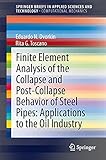Finite Element Analysis of the Collapse and Post-Collapse Behavior of Steel Pipes: Applications to the Oil Industry / by Eduardo N Dvorkin, Rita G. Toscano.
Tipo de material: TextoSeries SpringerBriefs in Applied Sciences and TechnologyEditor: Berlin, Heidelberg : Springer Berlin Heidelberg : Imprint: Springer, 2013Descripción: vii, 98 páginas 81 ilustraciones, 66 ilustraciones en color. recurso en líneaTipo de contenido:
TextoSeries SpringerBriefs in Applied Sciences and TechnologyEditor: Berlin, Heidelberg : Springer Berlin Heidelberg : Imprint: Springer, 2013Descripción: vii, 98 páginas 81 ilustraciones, 66 ilustraciones en color. recurso en líneaTipo de contenido: - texto
- computadora
- recurso en línea
- 9783642373619
- TA405-409.3
Springer eBooks
Introduction -- Shell element formulations for general nonlinear analysis Modeling techniques -- Collapse and post-collapse behavior of steel pipes Finite element models -- Experimental validation of the finite element models Applications: slotted pipes and axial loads -- Collapse and post-collapse behavior of deepwater pipelines with buckle arrestors. Cross-over mechanisms -- Conclusions.
This book presents a detailed discussion of the models that were developed to simulate the collapse and post-collapse behavior of steel pipes. The finite element method offers to engineers the possibility of developing models to simulate the collapse behavior of casings inside oil wells and the collapse behavior of deepwater pipelines. However, if technological decisions are going to be reached from these model results, with implications for the economic success of industrial operations, for the occupational safety and health and for the environment, the engineering models need to be highly reliable. Using these models engineers can quantify the effect of manufacturing tolerances, wear, corrosion, etc. This book describes in great details the experimental programs that are developed to validate the numerical results.
Para consulta fuera de la UANL se requiere clave de acceso remoto.


